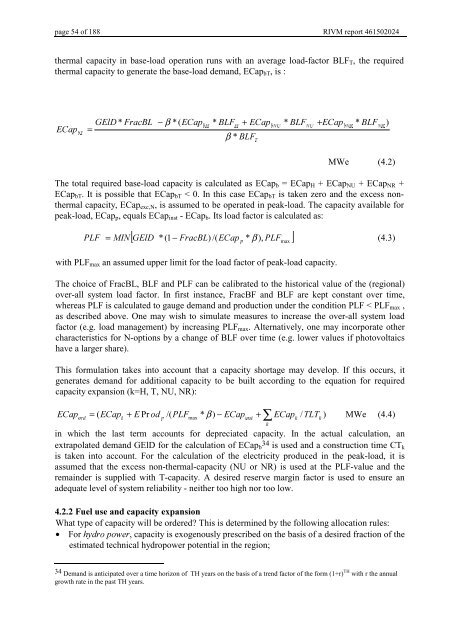Targets IMage Energy Regional (TIMER) Model, Technical ...
Targets IMage Energy Regional (TIMER) Model, Technical ...
Targets IMage Energy Regional (TIMER) Model, Technical ...
Create successful ePaper yourself
Turn your PDF publications into a flip-book with our unique Google optimized e-Paper software.
page 54 of 188 RIVM report 461502024<br />
thermal capacity in base-load operation runs with an average load-factor BLF T , the required<br />
thermal capacity to generate the base-load demand, ECap bT , is :<br />
(&DS<br />
E7<br />
*(O' * )UDF%/<br />
=<br />
− β *((&DS<br />
* %/) + (&DS * %/) + (&DS<br />
E+<br />
+<br />
β * %/)<br />
7<br />
E18<br />
18<br />
E15<br />
* %/)<br />
15<br />
)<br />
MWe (4.2)<br />
The total required base-load capacity is calculated as ECap b = ECap H + ECap NU + ECap NR +<br />
ECap bT . It is possible that ECap bT < 0. In this case ECap bT is taken zero and the excess nonthermal<br />
capacity, ECap exc,N , is assumed to be operated in peak-load. The capacity available for<br />
peak-load, ECap p , equals ECap inst - ECap b . Its load factor is calculated as:<br />
[ * (1 − )UDF%/) /((&DS<br />
* ), 3/) ]<br />
3/) = 0,1 *(O'<br />
β<br />
(4.3)<br />
S<br />
with PLF max an assumed upper limit for the load factor of peak-load capacity.<br />
The choice of FracBL, BLF and PLF can be calibrated to the historical value of the (regional)<br />
over-all system load factor. In first instance, FracBF and BLF are kept constant over time,<br />
whereas PLF is calculated to gauge demand and production under the condition PLF < PLF max ,<br />
as described above. One may wish to simulate measures to increase the over-all system load<br />
factor (e.g. load management) by increasing PLF max . Alternatively, one may incorporate other<br />
characteristics for N-options by a change of BLF over time (e.g. lower values if photovoltaics<br />
have a larger share).<br />
This formulation takes into account that a capacity shortage may develop. If this occurs, it<br />
generates demand for additional capacity to be built according to the equation for required<br />
capacity expansion (k=H, T, NU, NR):<br />
(&DS<br />
RUG<br />
= ((&DSE<br />
+ ( Pr RG<br />
S<br />
/( 3/)<br />
max<br />
* β ) − (&DSLQVW<br />
+ ∑ (&DSN<br />
/ 7/7N<br />
) MWe (4.4)<br />
N<br />
in which the last term accounts for depreciated capacity. In the actual calculation, an<br />
extrapolated demand GElD for the calculation of ECap b<br />
34 is used and a construction time CT k<br />
is taken into account. For the calculation of the electricity produced in the peak-load, it is<br />
assumed that the excess non-thermal-capacity (NU or NR) is used at the PLF-value and the<br />
remainder is supplied with T-capacity. A desired reserve margin factor is used to ensure an<br />
adequate level of system reliability - neither too high nor too low.<br />
)XHOXVHDQGFDSDFLW\H[SDQVLRQ<br />
What type of capacity will be ordered? This is determined by the following allocation rules:<br />
• For K\GURSRZHU, capacity is exogenously prescribed on the basis of a desired fraction of the<br />
estimated technical hydropower potential in the region;<br />
max<br />
34 Demand is anticipated over a time horizon of TH years on the basis of a trend factor of the form (1+r) TH with r the annual<br />
growth rate in the past TH years.
















